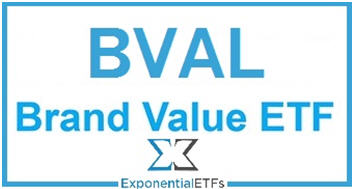Despite the recent hoopla surrounding all of the new ETFs coming to market focusing on various investment factors, the factors themselves have been around for decades. I myself have been a huge fan of the momentum factor since the mid-1980s, and the value factor is probably centuries old. Most of these new ETFs are not new investment approaches—they are the same old “standard” investment factors combined, sliced, diced, and repackaged as an ETF (with seemingly great backtested results). However, in one small corner of the ETF universe, there is some true innovation taking place—capturing intangible factors such as brand value. Yesterday’s introduction of the Brand Value ETF (BVAL) is just such a product.
 When companies issue their quarterly and annual reports, the words, numbers, and insights can go on for pages and pages. The company will value its buildings, equipment, inventories, loans, and a host of other items, but nowhere will you find a line item entry that places a value on the company’s brand. Often the centerpiece of information in merger and acquisition transactions, brand value tends to be a missing ingredient in regular ongoing financial statements.
When companies issue their quarterly and annual reports, the words, numbers, and insights can go on for pages and pages. The company will value its buildings, equipment, inventories, loans, and a host of other items, but nowhere will you find a line item entry that places a value on the company’s brand. Often the centerpiece of information in merger and acquisition transactions, brand value tends to be a missing ingredient in regular ongoing financial statements.
The primary reason companies do not report on this aspect of corporate value is because of the historically qualitative nature of intangible assets such as brand value and customer satisfaction. The Brand Value ETF (BVAL) solves this dilemma with a rules-based index built from quantifiable data. This new ETF, launched yesterday (June 13, 2017) by Exponential ETFs and Brandometry, seeks to outperform the market by investing in companies with strong brands that are not fully valued by the market.
The Importance of Brand
According to the Federal Reserve Bank, the U.S. economy holds more than $14 trillion in intangible assets, representing the majority of the entire economy. This translates into brand being the most valuable asset for many companies, even if it does not appear on the balance sheet. It also implies that brand is the most overlooked factor in traditional security analysis.
“We believe Intangible assets represent the next frontier in stock valuation. The Brand Value ETF captures and capitalizes on the work of Brandometry to quantify the brand value of publicly traded companies,” says Phil Bak, CEO of Exponential ETFs.
A company’s brand is continually relevant, is key to its marketing, and summarizes “what you know” about a company. For a company, brand can be a leading indicator of its current health and its future financial success. Despite its importance, GAAP accounting methods fail to capture this significant component of corporate value. “Brand” is a collection of perceptions about a company, its assets, its people, and its conduct.
Index Process
All good investment strategies require a security selection process, and for smart-beta ETFs, that process resides in the underlying index. The BrandTransact50 Index seeks to identify companies worthy of investment that share high growth potential and positive brand resonance. It uses a rules-based methodology to identify strong brands that maintain brand equity value not recognized in share price. The Index is composed of the 50 companies with the highest Brand Value scores (the ratio of their BrandPower score to market capitalization), equally weighted, and reconstituted annually. To be included in the Index, a company needs to be part of the Wilshire 5000 Index and have their brand scored by Tenet Partners, a leading brand innovation and marketing consulting firm.
Tenet Partners annually surveys approximately 10,000 individuals on the subject of company brands. Survey questions are designed to gather quantitative information on both brand familiarity and brand favorability. These results are objectively tabulated to determine the “BrandPower” score for each company. The Index then selects the 50 companies with the largest BrandPower-to-market-capitalization ratio—the 50 most undervalued companies based on Brand Value. Because of the nature of brands, the Index is expected to be primarily composed of large-capitalization companies and have a significant exposure to the Consumer Discretionary sector. Additional information is located in the BrandTransact50 Index Methodology document.
ETF Facts
A top-10 list of companies having the highest BrandPower-to-market capitalization ratios was not available at the time of this writing. However, all 50 of the top-scored companies included in the Index can be found in the list of BVAL’s holdings (downloadable here). As you would expect, all 50 names are recognizable, even to noninvestors.
The underlying index is equally weighted, therefore BVAL’s current top-10 holdings represent the securities that have performed the best since the last rebalancing (August 31, 2016). The firms are Best Buy (BBY), Bank of America (BAC), Wendy’s (WEN), Morgan Stanley (MS), Charles Schwab (SCHW), Tiffany & Co. (TIF), Marriott (MAR), Boeing (BA), and American Airlines (AAL). Current sector exposures include Consumer Discretionary 48%, Technology 18%, Financials 17%, Industrials 12%, and Consumer Staples 5%.
BVAL will be added to the U.S. Single-Factor Strategies (smart-beta) category of the ETF Field Guide. It has an expense ratio of 0.65%, and dividends will be paid annually. The fund’s investment advisor is ACSI Funds, the firm behind another intangible asset-factor ETF, the American Customer Satisfaction Core Alpha ETF (ACSI).
Additional information is located in the Fact Sheet, the BVAL prospectus, and the Brandometry website.
Disclosure: Author has no positions in any of the securities mentioned and no positions in any of the companies or ETF sponsors mentioned. No income, revenue, or other compensation (either directly or indirectly) is received from, or on behalf of, any of the companies or ETF sponsors mentioned.